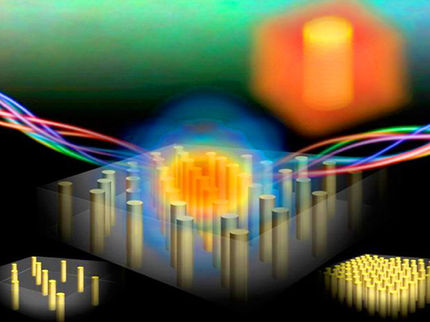Nano Dandelions
Bundles of cysteine-lead nanowires spread into highly oriented structures
Under an electron microscope they look like dandelions. In the journal Angewandte Chemie, Xiao-Fang Shen and Xiu-Ping Yan explain their nanoscopic bouquets: They consist of spread-out bundles of nanowires made of lead and the amino acid l-cysteine. The Chinese researchers have discovered a new, cost-effective method by which ordered nanostructures can be produced on a large scale, at room temperature, and under atmospheric pressure.
The properties of nanomaterials are not determined exclusively by their chemical composition; other characteristics such as structure and morphology, as well as the form, size, and spatial distribution of the individual particles, also play a role. It is equally important for the construction of future nanocomponents that nanomaterials can be produced with controlled "architecture". For example, one-dimensional nanoobjects, known as nanowires, are needed for the (opto)electronics of the future and for the construction of superordinate structures.
Thanks to their specific structures and fascinating penchant for self-assembly, biomaterials make particularly interesting "molds" for the production of defined inorganic nanostructures. In particular, the amino acid cysteine easily forms coordination compounds with inorganic cations and metals.
The research team at Nankai University started with an aqueous solution of cysteine and lead acetate. At room temperature and under certain conditions, spindly bundles of nanowires form. These bundles spread out to form dandelion-like structures with a highly oriented morphology.
When heated under hydrothermal conditions, these structures decompose. Depending on the reaction conditions, hierarchical lead sulfide microstructures are formed with various attractive shapes, including spherical, needle-like, and different flower-like structures. Lead sulfide is an important semiconductor.
"Our new process enables the simple, controlled synthesis of nanowires and three-dimensional lead sulfide microstructures," summarizes Yan. "In addition, we expect to gain new insights into the fundamental processes involved in mineralization, the transformation of bioorganic nano- and microstructures into inorganic structures. This process also occurs in living organisms, in which it plays an important role."
Original publication: Xiu-Ping Yan et al.; "Facile Shape-Controlled Synthesis of Well-Aligned Nanowire Architectures in Binary Aqueous Solution"; Angewandte Chemie International Edition 2007.
Other news from the department science
Most read news
More news from our other portals
See the theme worlds for related content
Topic world Synthesis
Chemical synthesis is at the heart of modern chemistry and enables the targeted production of molecules with specific properties. By combining starting materials in defined reaction conditions, chemists can create a wide range of compounds, from simple molecules to complex active ingredients.

Topic world Synthesis
Chemical synthesis is at the heart of modern chemistry and enables the targeted production of molecules with specific properties. By combining starting materials in defined reaction conditions, chemists can create a wide range of compounds, from simple molecules to complex active ingredients.




























































